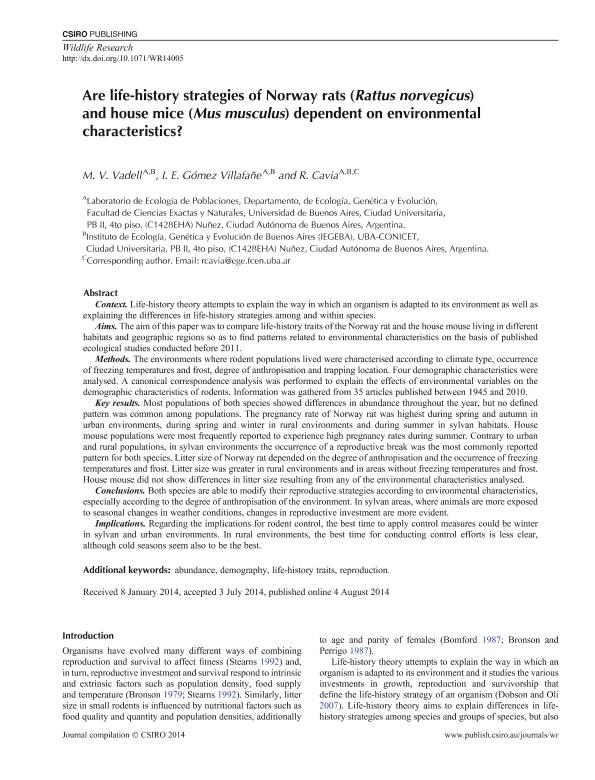Mostrar el registro sencillo del ítem
dc.contributor.author
Vadell, María Victoria

dc.contributor.author
Gomez Villafañe, Isabel Elisa

dc.contributor.author
Cavia, Regino

dc.date.available
2017-12-27T20:02:11Z
dc.date.issued
2014-08
dc.identifier.citation
Cavia, Regino; Gomez Villafañe, Isabel Elisa; Vadell, María Victoria; Are life-history strategies of Norway rats (Rattus norvegicus) and house mice (Mus musculus) dependent on environmental characteristics?; Csiro Publishing; Wildlife Research; 41; 2; 8-2014; 172-184
dc.identifier.issn
1035-3712
dc.identifier.uri
http://hdl.handle.net/11336/31723
dc.description.abstract
Context: Life-history theory attempts to explain the way in which an organism is adapted to its environment as well as explaining the differences in life-history strategies among and within species. Aims: The aim of this paper was to compare life-history traits of the Norway rat and the house mouse living in different habitats and geographic regions so as to find patterns related to environmental characteristics on the basis of published ecological studies conducted before 2011. Methods: The environments where rodent populations lived were characterised according to climate type, occurrence of freezing temperatures and frost, degree of anthropisation and trapping location. Four demographic characteristics were analysed. A canonical correspondence analysis was performed to explain the effects of environmental variables on the demographic characteristics of rodents. Information was gathered from 35 articles published between 1945 and 2010. Key results: Most populations of both species showed differences in abundance throughout the year, but no defined pattern was common among populations. The pregnancy rate of Norway rat was highest during spring and autumn in urban environments, during spring and winter in rural environments and during summer in sylvan habitats. House mouse populations were most frequently reported to experience high pregnancy rates during summer. Contrary to urban and rural populations, in sylvan environments the occurrence of a reproductive break was the most commonly reported pattern for both species. Litter size of Norway rat depended on the degree of anthropisation and the occurrence of freezing temperatures and frost. Litter size was greater in rural environments and in areas without freezing temperatures and frost. House mouse did not show differences in litter size resulting from any of the environmental characteristics analysed. Conclusions: Both species are able to modify their reproductive strategies according to environmental characteristics, especially according to the degree of anthropisation of the environment. In sylvan areas, where animals are more exposed to seasonal changes in weather conditions, changes in reproductive investment are more evident. Implications: Regarding the implications for rodent control, the best time to apply control measures could be winter in sylvan and urban environments. In rural environments, the best time for conducting control efforts is less clear, although cold seasons seem also to be the best.
dc.format
application/pdf
dc.language.iso
eng
dc.publisher
Csiro Publishing

dc.rights
info:eu-repo/semantics/openAccess
dc.rights.uri
https://creativecommons.org/licenses/by-nc-sa/2.5/ar/
dc.subject
Abundance
dc.subject
Demography
dc.subject
Mus Musculus
dc.subject
Rattus Norvegicus
dc.subject
Reproduction
dc.subject
Life History Traits
dc.subject.classification
Otras Ciencias Biológicas

dc.subject.classification
Ciencias Biológicas

dc.subject.classification
CIENCIAS NATURALES Y EXACTAS

dc.title
Are life-history strategies of Norway rats (Rattus norvegicus) and house mice (Mus musculus) dependent on environmental characteristics?
dc.type
info:eu-repo/semantics/article
dc.type
info:ar-repo/semantics/artículo
dc.type
info:eu-repo/semantics/publishedVersion
dc.date.updated
2017-12-27T15:20:13Z
dc.journal.volume
41
dc.journal.number
2
dc.journal.pagination
172-184
dc.journal.pais
Australia

dc.description.fil
Fil: Vadell, María Victoria. Consejo Nacional de Investigaciones Científicas y Técnicas. Oficina de Coordinación Administrativa Ciudad Universitaria. Instituto de Ecología, Genética y Evolución de Buenos Aires. Universidad de Buenos Aires. Facultad de Ciencias Exactas y Naturales. Instituto de Ecología, Genética y Evolución de Buenos Aires; Argentina
dc.description.fil
Fil: Gomez Villafañe, Isabel Elisa. Consejo Nacional de Investigaciones Científicas y Técnicas. Oficina de Coordinación Administrativa Ciudad Universitaria. Instituto de Ecología, Genética y Evolución de Buenos Aires. Universidad de Buenos Aires. Facultad de Ciencias Exactas y Naturales. Instituto de Ecología, Genética y Evolución de Buenos Aires; Argentina
dc.description.fil
Fil: Cavia, Regino. Consejo Nacional de Investigaciones Científicas y Técnicas. Oficina de Coordinación Administrativa Ciudad Universitaria. Instituto de Ecología, Genética y Evolución de Buenos Aires. Universidad de Buenos Aires. Facultad de Ciencias Exactas y Naturales. Instituto de Ecología, Genética y Evolución de Buenos Aires; Argentina
dc.journal.title
Wildlife Research

dc.relation.alternativeid
info:eu-repo/semantics/altIdentifier/doi/http://dx.doi.org/10.1071/WR14005
dc.relation.alternativeid
info:eu-repo/semantics/altIdentifier/url/http://www.publish.csiro.au/wr/WR14005
Archivos asociados
